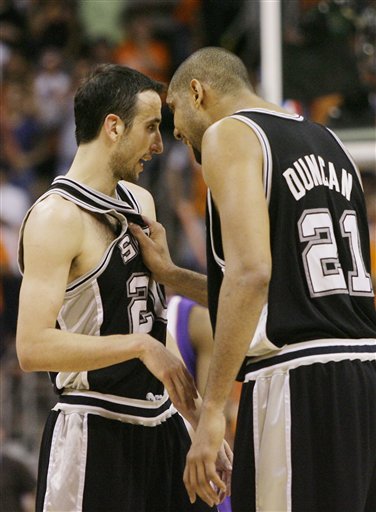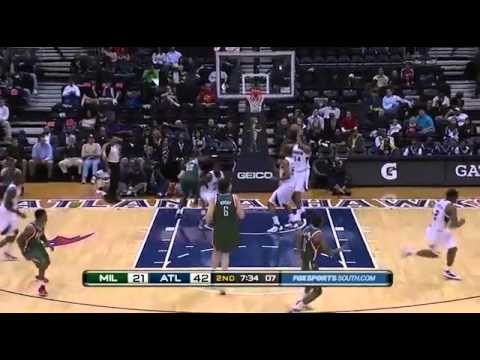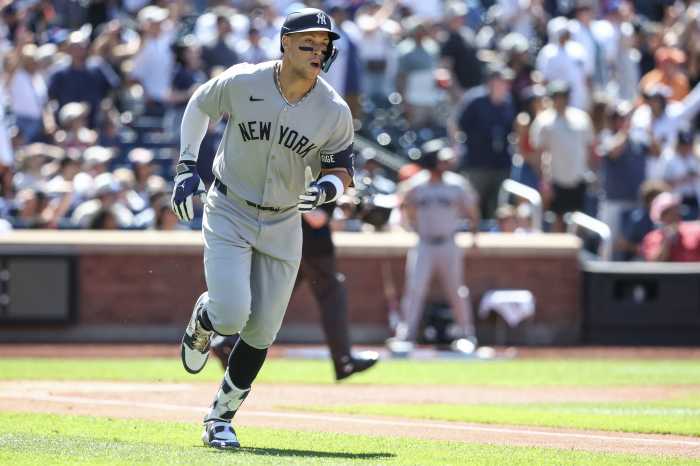For NBA stat heads, the day John Hollinger releases his PER projections is a big one. Hollinger, who is the one who created the PER a while back and is generally considered the authority on PER projections, released those numbers yesterday (ESPN Insider Only). Before we get to the projections, let’s do a quick PER refresher. PER, as John Hollinger explains, is:
To generate it, I created formulas — which I outlined in tortuous detail in the book “Pro Basketball Forecast” — that return a value for each of a player’s accomplishments. That includes positive accomplishments, such as field goals, free throws, 3-pointers, assists, rebounds, blocks and steals, and negative ones, such as missed shots, turnovers and personal fouls.
Two important things to remember about PER is that it’s per-minute and pace-adjusted.
It’s a per-minute measure because that allows us to compare, say, Jordan Farmar to Derek Fisher, even though there is a disparity in the minutes they played.
I also adjust each player’s rating for his team’s pace, so that players on a slow-paced team like Detroit aren’t penalized just because their team’s games have fewer possessions than those of a fast-paced team such as Golden State.
So what is PER used for? Again, John Hollinger answers:
What PER can do, however, is summarize a player’s statistical accomplishments in a single number. That allows us to unify the disparate data on each player that we try to track in our heads (e.g., Corey Maggette: free-throw machine, good rebounder, decent shooter, poor passer, etc.) so that we can move on to evaluating what might be missing from the stats.
Just to give everyone an idea of what PER numbers are good and bad, Hollinger posted a list of the top and bottom 10 in the league last year.
Alright, so now you know what PER is, let’s quickly take a look at how Hollinger comes up with his projections:
It’s not, as some suspect, by pulling numbers out of the air. Nor was my secret yet pervasive bias against your favorite team a factor, much as commenters like to feel otherwise.
I base the projections on a tool called similarity scores.
For each player, I use as a comparison the players from the past 20 years who are the most similar, based on age, height and stats over the past three seasons. Some players will have more comparables than others, depending on how unusual they are — guys with freak heights (Zydrunas Ilgauskas, Nate Robinson), freak ages (Shaquille O’Neal) or freak stats (Andrei Kirilenko) will have relatively few, while a more generic player like Al Harrington or Devin Brown could have over a hundred.
OK, now that all this is settled, let’s look at his projections of the Nets. It might not surprise you that Hollinger, who is down on the Nets this year (and it seems like he is always down on them), only has two players on the Nets projected to be a greater than average player (remember the PER of an average NBA is always set to 15.0). I don’t really take offense to that, but I do take offense to some of his projections/explanations.
Brook Lopez (18.82):
Brook has the 2nd highest PER projection on the team (31st overall/8th among Cs) with a PER projection of 18.82. So what’s the problem? I actually think it should be higher. Here is what Hollinger says:
Despite my admiration of his rookie campaign, I have to treat it with a small bit of suspicion given the expectations that accompanied Lopez entering the season. It’s obvious that Lopez is going to be a very good player for the next several seasons, but the question is how much better he can get from here. He’s neither an overwhelming athlete nor a tremendous shooter; it’s more that he’s pretty good across the board.
Additionally, the players that tend to improve the most as youngsters are the ones who have high turnover rates and strong athletic indicators (rebounds, blocks, steals, free throw attempts). Lopez’s rookie numbers were unimpressive in all of those areas except blocks, which makes me question how much upside remains. I suspect the answer is much less for him than it is for Rose, which is the one reason I emphasized above that Lopez was better as a rookie. But it doesn’t necessarily mean he’ll have the better career.
I don’t know. I just can’t believe that Brook isn’t going to improve vastly this year. Hollinger doesn’t seem to mention that Brook is going to get a lot more touches with Vince gone. On a team without a real go-to guy (there is still a debate if Devin can be this guy), and no real knock-down shooter, Brook could be a stabilizing factor on nights the Nets are having poor shooting nights. On nights like that, the Nets can just toss the ball down low and let Brook work.
Also, the preseason game really got me excited, and makes me believe Brook can outplay his projection (19 points in 12 minutes). I know it was a preseason game against a team that doesn’t have a real center, but the opponent matters little to me. No, what got me excited was that on two separate occasions when the Nets were running the floor, Brook just put his head down, sprinted to the block (beating smaller quicker defenders down the court), got the ball in transition and scored an easy bucket. That’s a big question going into the season. With all this talk about running and gunning, where is Brook going to get his touches. If those two possessions were any indication, Brook will be running as well, scoring a ton of easy buckets.
Terrence Williams (N/A):
He doesn’t project Terrence Williams’ PER (didn’t log over 500 minutes in the league), but Hollinger does provide this analysis:
History shows that the deck is stacked against Williams in multiple ways. Seniors drafted in the lottery tend to underperform relative to other classes. Players picked 11th tend to vastly underperform compared to those taken in the Top 10. Players coming from Rick Pitino-coached teams tend to greatly underperform for their draft position. And selections in the past two decades by Rod Thorn significantly underperformed those chosen by somebody else.
Of course, there are exceptions to every rule — for instance, Thorn picked a winner in the 2008 draft in Brook Lopez. Some think that Williams, too, has the skills to defy the historical factors working against him. For example, he’s a good athlete with plenty of size for a wing, he rebounds extremely well for his size and he can handle and pass the ball.
On the flip side, he’s mediocre at best from outside and atrocious at the free throw line, he’s not a great decision-maker and his quirky personality makes Gilbert Arenas seem like Tim Duncan. While he’ll have plenty of opportunities now that Vince Carter is in Orlando, the question remains as to whether Williams will make the most of them.
Ouch. That sure does paint a bleak picture, doesn’t it? I tend to think that Terrence is more of an exception than the rule (I know…I know…insert Sebastian and Terrence Williams love jokes here…), more so than Hollinger infers. Why? He does too many things well. He is a solid defender, a solid rebounder, a terrific passer. All these assets will help Terrence put up numbers…numbers the positively effect PER. Also, it seems to me that Hollinger is knocking Terrence for his personality. I don’t think that is fair, especially because all the reports coming out before/during camp have painted him as the hardest working Net.
—
This isn’t designed to be a bash piece on John Hollinger…far from it, I actually love Hollinger’s pieces, and as someone just familiarizing himself with advanced statistics pertaining to basketball, I love reading Hollinger’s explanations of things. I also think that he got a number of projections on the Nets correct (I know everyone believes Hollinger when he says Hassell will get a PER of 6.86 – would be good for 7th worst last year). There are a few others I think he is spot on with:
Chris Douglas-Roberts (13.09):
It is pretty crazy to think that Hollinger projects CDR to have the third best PER on the team, but when you think about it, it makes sense. Let’s look at Hollinger’s explanation:
The trade of Vince Carter is a great opportunity for Douglas-Roberts, who could establish himself as a sixth man/scoring ace given the paucity of other shot creators on the Nets’ roster. As long as he can continue to create shots for his teammates in between the looks he gets for himself, the Nets will likely give him some opportunities to show what he can do.
This is spot-on analysis. CDR’s ability to score in bunches makes him a perfect candidate for the 6th man spot on this Nets team. Nights where the team is struggling to score, we just put CDR in and let him do what he does…and that is score.
Courtney Lee (10.71):
Courtney Lee’s projection is slightly lower than the number he put up with the Magic. As Hollinger puts it:
Lee was traded to New Jersey in the Vince Carter deal and should see extended playing time as the Nets’ starting shooting guard. While his team as a whole will be a far cry from the Magic squad he played on a season ago, the change of scenery will give him more opportunity to round out his offensive game. I suspect his shots and points will increase sharply but his percentages will go down.
Of course, Lee’s long-term value is more likely to come as a defender. He’ll be facing opponents’ best scorers every night in New Jersey without a lot of help, and while he’ll probably take some lumps this season, the experience should pay off in the long run as he tries to establish himself as a lockdown, one-on-one ace.
Hollinger is once again on point when saying Lee’s biggest asset will be his defense. He has the potential to be a shut down defender once he gets some of the nuances of defending in the NBA down. Also, his shooting efficiency numbers probably will go down, as Hollinger predicts. This is because with more minutes, Lee will shoot more, and as that happens his percentages should regress towards the mean. Once thing Hollinger doesn’t mention though is if Lee can maintain his shooting efficiency levels with the added playing time, Lee will be a scary two-way player.
Devin Harris (19.30): Harris’ PER projection for this year is good for 22nd in the NBA, though it is down a bit. Again, this makes total sense. I know what some of you are asking. If Carter leaves, shouldn’t that lead to more opportunities for Harris? The answer is yes. But with Carter gone, this could lead to more eyes on Harris. More double teams are going to be coming his way this year. It will be interesting to see how he handles it.
—
Well, that was fun wasn’t it? This stuff is real fun to talk about, but in the end, I can’t wait to start writing about some real NBA action. Oh and for those wondering, here are the rest of the Nets’ PER projections:
Rafer Alston 2009-10 Projected PER: 11.97
Tony Battie 2009-10 Projected PER: 9.96
Josh Boone 2009-10 Projected PER: 12.57
Keyon Dooling 2009-10 Projected PER: 12.87
Chris Douglas-Roberts 2009-10 Projected PER: 13.09
Devin Harris 2009-10 Projected PER: 19.30
Trenton Hassell 2009-10 Projected PER: 6.86
Jarvis Hayes 2009-10 Projected PER: 10.41
Yi Jianlian 2009-10 Projected PER: 11.48
Courtney Lee 2009-10 Projected PER: 10.71
Brook Lopez 2009-10 Projected PER: 18.82
Eduardo Najera 2009-10 Projected PER: N/A
Bobby Simmons 2009-10 Projected PER: 11.14
Sean Williams 2009-10 Projected PER: N/A
Terrence Williams 2009-10 Projected PER: N/A


















